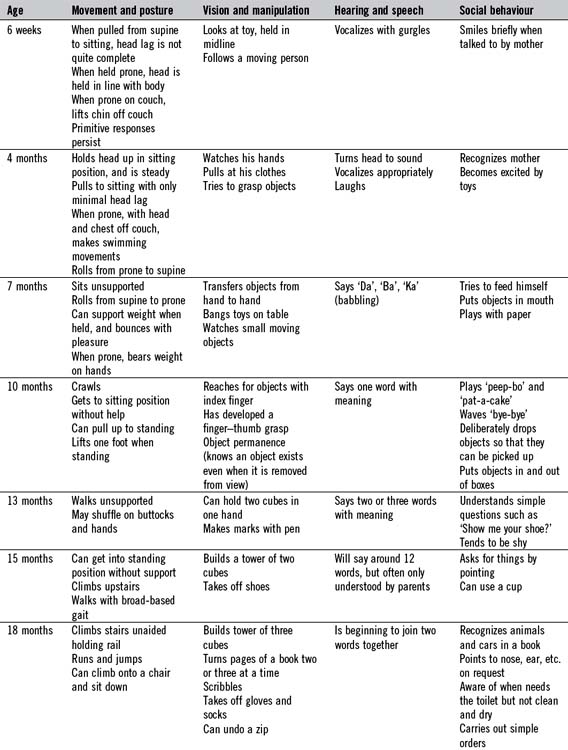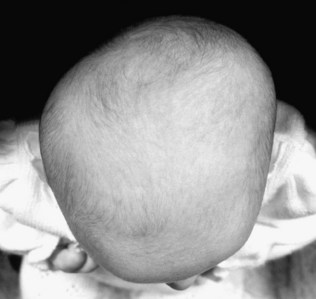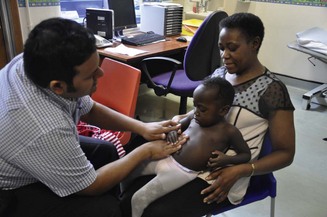5 Children and adolescents
History
The history (Box 5.1) will normally be taken from the accompanying carer, but an older child can be invited to give his version of events first. It is appropriate to give an adolescent the opportunity for a few minutes of confidential time during the consultation. Use this to ask questions about alcohol, drugs and sexual activity which he may be uncomfortable discussing in front of his parents. Even younger children should be asked simple things in words they can understand. Involve them by asking relevant points such as the site of the pain, etc. Remember that the carer is giving their version of the problem, not the child’s. Parents may also welcome an opportunity to talk in private away from the child, and it is often during such discussion that the real reason for the consultation emerges. Always take notice of what the carer is saying, and listen to their concerns. Any interruptions should be to clarify rather than try and direct the history. Make sure they are given full attention and that they feel their concerns are being taken seriously. All the time they are talking, keep watching everything that the child is doing and their reactions.
In children, the previous medical history starts from birth and specific attention should be paid to the pregnancy and newborn period (Box 5.2). Is the child fully immunized? This can be checked in the parent-held ‘red book’ or child health record, which should have documentation of child health clinic attendances, weights, immunizations, etc. Enquire particularly as to the nature and severity of previous illnesses and the age at which they occurred, for example common childhood infections such as chickenpox, admissions to hospital and, in particular, to intensive care, significant injuries and accidents. Is the child taking any regular medication and is he allergic to anything? It is important to ask about the child’s developmental progress: when did the child first sit up, smile, crawl, walk and talk? Fuller details regarding the ‘milestones of development’ are given in Table 5.1. Some useful general questions are outlined in Box 5.3.
Box 5.2 Pregnancy and infancy
 Did the mother have any particular illnesses or infections, or was she taking any drugs during the pregnancy (including alcohol)?
Did the mother have any particular illnesses or infections, or was she taking any drugs during the pregnancy (including alcohol)?
 What were the birth weight and type of delivery?
What were the birth weight and type of delivery?
 Were there any problems in the newborn period: jaundice, breathing problems, fits, feeding difficulties?
Were there any problems in the newborn period: jaundice, breathing problems, fits, feeding difficulties?
 Has the baby had any illnesses?
Has the baby had any illnesses?
 How was the baby fed? When were solid foods introduced?
How was the baby fed? When were solid foods introduced?
 Were there any intolerances to food?
Were there any intolerances to food?
Box 5.3 General questions
 What are the child’s present habits with regard to eating, sleeping, bowels and micturition?
What are the child’s present habits with regard to eating, sleeping, bowels and micturition?
 What sort of personality does he have – e.g. extrovert, moody?
What sort of personality does he have – e.g. extrovert, moody?
 Behaviour: anything unusual which the parent is worried about?
Behaviour: anything unusual which the parent is worried about?
 How does he get on with other children?
How does he get on with other children?
 How does the child compare with siblings or friends of the same age?
How does the child compare with siblings or friends of the same age?
 School: which school, does he like it, academic achievement, does he miss much school?
School: which school, does he like it, academic achievement, does he miss much school?
Family history
 How old are the parents? Are they consanguineous?
How old are the parents? Are they consanguineous?
 How many children are there in the family? What are their ages and sex?
How many children are there in the family? What are their ages and sex?
 Who else lives in the family home?
Who else lives in the family home?
 Have there been any stillbirths, miscarriages or other childhood deaths in the family?
Have there been any stillbirths, miscarriages or other childhood deaths in the family?
 Are there any illnesses in the siblings, parents or any near relatives?
Are there any illnesses in the siblings, parents or any near relatives?
Examination
A key principle in the examination of children is that most of the information needed to make a diagnosis will be gleaned from careful observation, including listening to the child and playing with him. Findings can then be consolidated with the remaining techniques requiring laying on of hands. Older children will usually cooperate sufficiently to be examined lying down, and routine physical examination is similar to an adult examination. A younger child should be examined sitting on his carer’s lap, as any attempt to get him to lie down will result in instant distress. Always talk to children however young; do not be afraid of looking silly if the result is a cooperative child. Those parts of the examination that are painful or unpleasant should be left until last: if an attempt is made to examine a child’s throat at the outset, the immediate response will be crying. Offer the child something to play with – even a stethoscope will be a source of amusement to a young infant. Children often find it amusing if their toy is examined first. The scheme set out in Box 5.4 can be adapted opportunistically, provided all areas are covered.
The head, face and neck
Look at the child’s face and ask the following questions:
 Does it look normal? If not, try to identify which features seem unusual. There are many hundreds of syndromes diagnosable by the facial appearance, and the salient features should be carefully noted.
Does it look normal? If not, try to identify which features seem unusual. There are many hundreds of syndromes diagnosable by the facial appearance, and the salient features should be carefully noted.
 If the baby looks dysmorphic, then do not forget to look at the parents. It may then be obvious that what seems abnormal may be nothing more than a family trait. If the appearance is still not too clear, ask who the baby looks like.
If the baby looks dysmorphic, then do not forget to look at the parents. It may then be obvious that what seems abnormal may be nothing more than a family trait. If the appearance is still not too clear, ask who the baby looks like.
 Does the child have a large or protruding tongue?
Does the child have a large or protruding tongue?
 Are the ears in the normal position, or are they low set and abnormal in any way?
Are the ears in the normal position, or are they low set and abnormal in any way?
 Are the eyes small (microphthalmus)? Are they set close together or wide apart (hypo- or hypertelorism)?
Are the eyes small (microphthalmus)? Are they set close together or wide apart (hypo- or hypertelorism)?
Next note the shape of the head. This needs to be done by viewing the child’s head from the front, sides and from above. It may be small if the baby is microcephalic, globular if the baby is hydrocephalic, sometimes with dilated veins over the skin surface, or brachycephalic (flattened over the occiput), for example in trisomy 21. It is often asymmetrical (plagiocephalic) in normal infants who tend to lie with their heads persistently on one side (Fig. 5.1). This is now much more common because babies are placed on their backs to sleep in order to reduce the risk of sudden death in infancy. It becomes much less noticeable as the child grows older.
The abdomen
The abdomen can be a little difficult to examine if the baby is crying, which is why it is important to have gained the child’s cooperation by this point in the examination. Most infants and toddlers will need to be examined while sitting on their carer’s lap (Fig. 5.2). It is sometimes possible to quieten a crying infant by placing him over his mother’s shoulder and examining him from behind. Small infants can be given a feed to quieten them. Older children can be asked if they would be happy to lie on an examination couch.
The examination needs to be structured along the three essential components of looking (observation), feeling (palpation) and listening (auscultation). During the first 3 years of life, the abdomen often gives an impression of being protuberant due to the laxity of the rectus muscles. Causes of true abdominal distension are shown in Box 5.5. Look for any obvious distension or for peristaltic waves suggesting intestinal obstruction. Note the umbilicus, and whether or not there is a hernia. Palpation should be gentle and light. Always ask the child if his tummy hurts anywhere and watch his facial expression during palpation. The liver edge can be felt in normal children up to the age of 4 years; it can be anything up to 2 cm below the costal margin. When enlarged, the spleen may be felt below the left costal margin, and in infancy it is more anterior and superficial than in the older child or adult. Slight enlargement of the spleen can occur in many childhood infections. Causes of hepatosplenomegaly are listed in Table 5.2. Faecal masses can be felt in the left iliac fossa in constipated children. They often feel like a sausage which can be rolled underneath the finger tips. A full or distended bladder presents as a mass arising from the pelvis. Deep palpation of the kidneys can be carried out last. Although it would be logical to examine the groin area at this time, it is often better to do this at a later stage. If the child has cried persistently, it is still possible to examine the abdomen. When the baby breathes in and the abdominal muscles relax, the abdominal viscera and other masses, if present, can be palpated.
Table 5.2 Causes of hepatomegaly and splenomegaly in children
| Hepatomegaly | Splenomegaly | Hepatosplenomegaly |
|---|---|---|





































